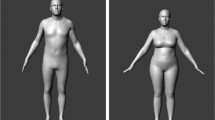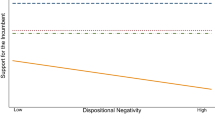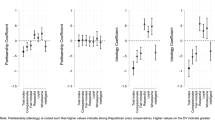Abstract
Three experiments investigated the role of stereotypic and nonstereotypic criteria in judgments of political candidates. The effects of physical attractiveness, political party, and stands on specific issues on both absolute and comparative judgments of political candidates were examined to evaluate three hypotheses about stereotype and attribute use. In the absence of other information, candidates' physical attractiveness (conveyed through photographs) had a substantial influence on subjects' global evaluations of them and inferences of both their personal qualities and their political ideology. When other information about the candidates' party membership and stands on specific issues was available, however, the candidates' attractiveness had no effect on the evaluations of them. When subjects made judgments of only one candidate, subjects relied exclusively on the candidate's voting record. When subjects were asked to make comparative judgments of two candidates, however, they based their judgments on each candidate's party membership and not on their respective voting records. Implications of these results for the processes that underlie political judgments and decisions are evaluated.
Similar content being viewed by others
References
Asher, H. B. (1983). Voting behavior research in the 1980s: An examination of some old and new problem areas. In A. W. Finifter (ed.),Political Science: The State of the Discipline. Washington, DC: American Political Science Association.
Bodenhausen, G. V., and M. Lichtenstein (1987). Social stereotypes and information-processing strategies: The impact of task complexity.Journal of Personality and Social Psychology 52:871–880.
Bodenhausen, G. V., and R. S. Wyer (1985). Effects of stereotypes on decision-making and information-processing strategies.Journal of Personality and Social Psychology 48:267–282.
Campbell, A., P. E. Converse, W. E. Miller, and D. E. Stokes (1960).The American Voter. Chicago: University of Chicago Press.
Campbell, A., G. Gurin, and W. E. Miller (1954).The Voter Decides. Evanston, IL: Row and Peterson.
Carlston, D. E. (1980). The recall and use of observed behavioral episodes and inferred traits of social inference processes.Journal of Social Experimental Psychology 16:779–804.
Conover, P., and S. Feldman (1986). The role of inference in the perception of political candidates. In R. R. Lau and D. O. Sears (eds.),Political Cognition: The 19th Annual Carnegie Symposium on Cognition. Hillsdale, NJ: Erlbaum.
Deaux, K., and L. L. Lewis (1984). Structure of gender stereotypes: Interrelationships among components and gender label.Journal of Personality and Social Psychology 46:991–1104.
Dion, K. K., E. Bersheid, and E. H. Walster (1972). What is beautiful is good.Journal of Personality and Social Psychology 24:285–290.
Futoran, G. C., and R. S. Wyer, Jr. (1986). The effects of traits and gender-stereotypes on occupational suitability judgments and the recall of judgment-relevant information.Journal of Experimental Social Psychology 22:475–503.
Hamilton, David L., ed. (1981).Cognitive Processes in Stereotyping and Intergroup Behavior. Hillsdale, NJ: Erlbaum.
Herstein, J. (1981). Keeping the voter's limits in mind: A cognitive process analysis of decision making in voting.Journal of Personality and Social Psychology 40:843–861.
Hinkley, B. (1981).Congressional Elections. Washington, DC: Congressional Quarterly Press.
Hinkley, B., R. Hofstetter, and J. Kessel (1974). Information and the vote: A comparative election study.American Politics Quarterly 2:131–158.
Hong, S., and R. S. Wyer (1989). Country of origin, attributes, and product evaluations: The effects of time delay between information and judgments.Journal of Consumer Research 16:175–187.
Kinder, D. R. (1986). Presidential character revisited. In R. R. Lau and D. O. Sears (eds.),Political Cognition (pp. 233–255). Hillsdale, NJ: Erlbaum.
Kinder, D. R., and R. P. Abelson (1981). Appraising presidential candidates: Personality and affect in the 1980 campaign. Paper delivered at the 1981 annual meeting of the American Political Science Association, New York, 3–6 September.
Knight, K. (1985). Ideology in the 1980 election: Ideological sophistication does matter.Journal of Politics 47:828–853.
Locksley, A., E. Borgida, N. Brekke, and C. Hepburn (1980). Sex stereotypes and social judgment.Journal of Personality and Social Psychology 39:821–831.
Locksley, A., C. Hepburn, and V. Ortiz (1982). Social stereotypes and judgments of individuals: An instance of the base-rate fallacy.Journal of Experimental Psychology 18:12–42.
Luskin, R. C. (1987). Measuring political sophistication.American Journal of Political Science 31:856–899.
Markus, G. B., and P. E. Converse (1979). A dynamic simultaneous equation model of electoral choice.American Political Science Review 73:1055–1070.
Miller, A. H., M. P. Wattenburg, and O. Malanchuk (1986). Schematic assessments of political candidates.American Political Science Review 80:521–540.
Montgomery, H. (1983). Decision rules and the search for a dominance structure: Towards process model of decision making. In P. Humphreys, O. Svenson, and A. Vari (eds.),Analyzing and Aiding Decision Processes (pp. 343–369). Amsterdam: North-Holland.
Ottati, V. C. (1990). Determinants of political judgments: The joint influence of normative and heuristic rules of inference.Political Behavior 12:159–179.
Ottati, V. C., E. D. Riggle, R. S. Wyer, N. Schwarz, and J. Kuklinski (1989). Cognitive and affective bases of opinion survey responses.Journal of Personality and Social Psychology 57:404–415.
Ottati, V. C., and R. S. Wyer (1990). The cognitive mediators of political information processing. In J. A. Ferejohn and J. H. Kuklinski (eds.),Information and Democratic Process. Urbana, IL: University of Illinois Press.
Page, B. I., and R. A. Brody (1972). Policy voting and the electoral process.American Political Science Review 66:979–995.
Rabinowitz, G. (1978). On the nature of political issues.American Journal of Political Science 22:793–817.
Rahn, W. M. (1989). The role of partisan stereotypes in information processing about political candidates. Paper presented at the Annual Meeting of the American Political Science Association, Atlanta, GA.
Repass, D. E. (1971). Issue salience and party choice.American Political Science Review 65:389–400.
Riggle, E. D., T. L. Budesheim, and R. S. Wyer (1990). Temporal effects on judgments of political candidates. Paper presented at the Annual Meeting of the American Political Science Association, San Francisco, CA.
Rosenberg, S. W., L. Bohan, P. McCafferty, and K. Harris (1986). The image and the vote: The effect of candidate presentation of voter preference.American Journal of Political Science 30:108–127.
Rosenberg, S. W., and P. McCafferty (1987). The image and the vote: Manipulating voters' preferences.Public Opinion Quarterly 51:31–47.
Schwarz, N., and R. S. Wyer (1985). Effects of rank ordering stimuli on magnitude ratings of these and other stimuli.Journal of Experimental Social Psychology 21:30–46.
Sherman, S. J., K. Ahlm, L. Berman, and S. Lynn (1978). Contrast effects and their relationship to subsequent behavior.Journal of Experimental Social Psychology 14:340–350.
Sigelman, C. K., D. B. Thomas, L. Sigelman, and F. D. Ribich (1986). Gender, physical attractiveness, and electability: An experimental investigation of voter biases.Journal of Applied Social Psychology 16:229–248.
Sniderman, P. M., J. M. Glaser, and R. Griffin (1990). Information and electoral choice. In J. A. Ferejohn and J. H. Kuklinski (eds.),Information and Democratic Processes (pp. 117–135). Urbana, IL: University of Illinois.
Weisberg, H. F., and J. G. Rusk (1970). Dimensions of candidate evaluations.American Political Science Review 60:19–28.
Wyer, R. S., and T. K. Srull (1989).Human Cognition in Its Social Context. Hillsdale, NJ: Erlbaum.
Author information
Authors and Affiliations
Rights and permissions
About this article
Cite this article
Riggle, E.D., Ottati, V.C., Wyer, R.S. et al. Bases of political judgments: The role of stereotypic and nonstereotypic information. Polit Behav 14, 67–87 (1992). https://doi.org/10.1007/BF00993509
Issue Date:
DOI: https://doi.org/10.1007/BF00993509




